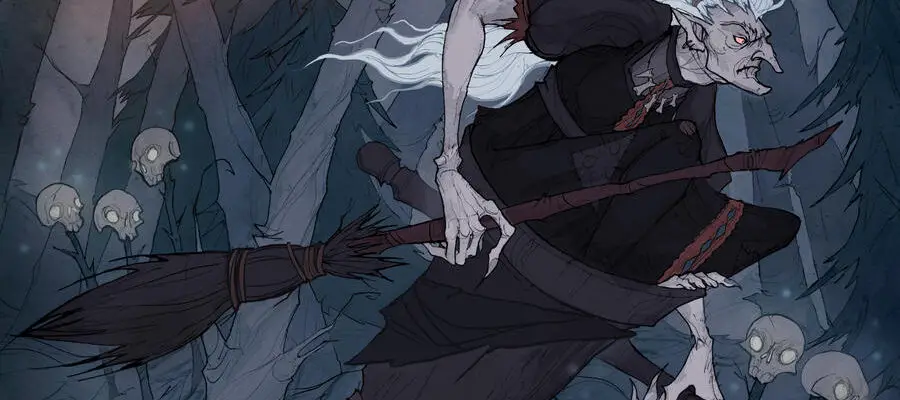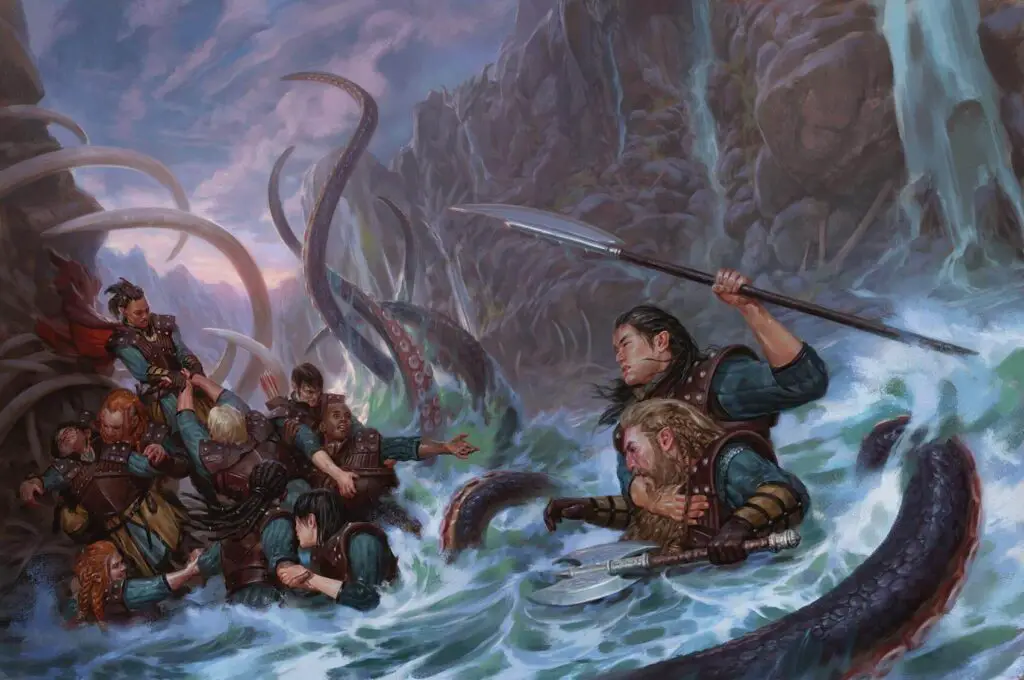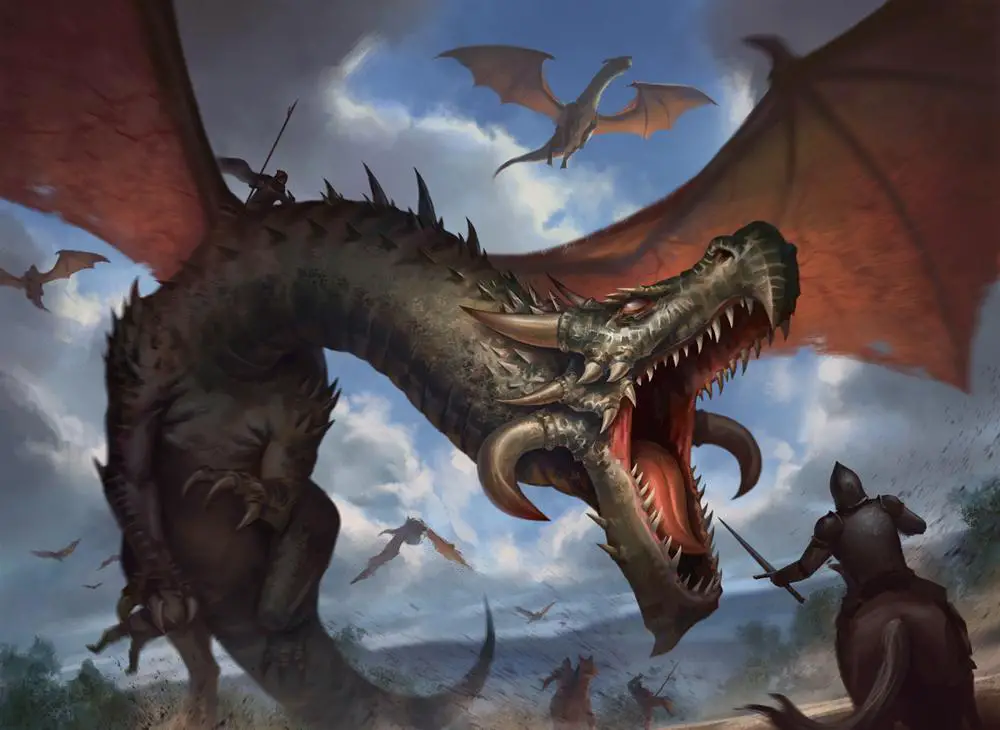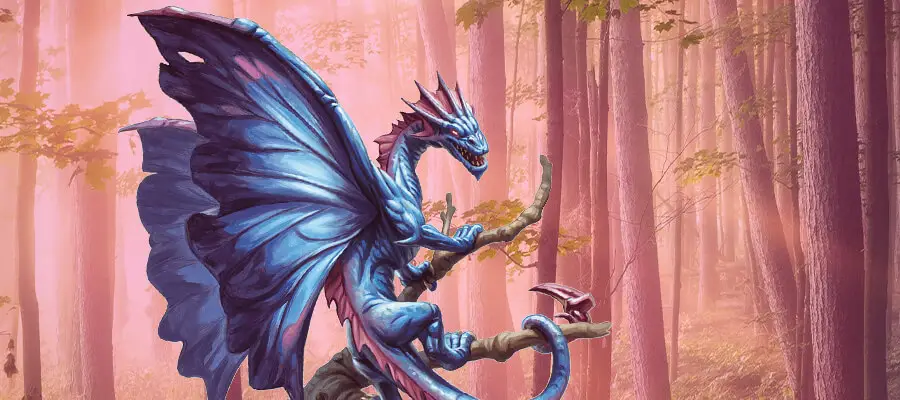This article’s featured image is provided by IrenHorrors, CC License 3.0. This article contains affiliate links that add gold to our coffers.
A notorious nightmare for children across the world, the tales of Baba Yaga vary from culture to culture, yet all leave a feeling of dread of the old forest witch. Unsurprisingly, Dungeons & Dragons has also incorporated their own version of the story into their canon, maintaining the themes of wickedness and whimsy. In history, Baba Yaga transformed from a narrative of a wise old crone with cultural significance to a fable of a child-eating witch, as mythology made way for incoming religion. Yet, there is much we can learn, from both the history of Baba Yaga and from the lore both within and outside Dungeons & Dragons, about creating a fulfilling and complex villain.
The Lore of Baba Yaga
Baba Yaga in Real-World Culture
From Baba Yaga’s Book of Witchcraft, we learn that this scary old forest crone was once seen as a wise witch who imparted an earnest listener with valuable knowledge of life and magic. When Christianity overtook folk customs in Slavic countries, the legend of wisdom was brutalized into a figment of horror.
Though traditions differ across culture and folklore, the general story of Baba Yaga can be described as either a supernatural spirit or deity, or as one of three sisters who go by the same name. Called “Mistress of the Woods,” or any variation on her name, the trickster Baba Yaga generally flies across the lands in a mortar, with a pestle in one hand to propel the craft and a broom in the other to sweep away her tracks. She resides in a sentient home propped up on chicken legs and plays the role of teacher, midwife, sorceress, witch, grandmother, fortune teller, villain, protector, and so much more.
With her bony leg, matted hair, baggy skin, and particularly long nose, Baba Yaga is first mentioned in folklore as a goddess of death. As villagers made blood sacrifices to the frightening figure, Iagaia Baba fed the blood to her two granddaughters. Other cultures revered her as the goddess of nature, who is sometimes cruel but often provides sustenance, detached from the desires of mankind. Another legend explains her creation as the devil cooking twelve wicked women in a cauldron, into which he spit. From the cauldron arose the embodiment of pure evil: Baba Yaga.
The Tale of Vasilissa
One of the most noteworthy tales of Baba Yaga involves a beautiful protagonist girl named Vasilissa or Vasylyna, whose mother fell ill when she was a child. The plot always involves the passing of the mother, and the remarriage of the father. With the addition of a stepmother and her two daughters, Vasilissa did the bidding of her stepmother, who plotted to rid the household of the girl.
In one telling, the stepsisters tripped Vasilissa, who dropped an iron pot holding a burning coal, the only source of heat and warmth in their secluded home. The stepmother scolded the girl and commanded her to enter the forest and steal fire from Baba Yaga. Taking only some bread and salt, and a doll and shawl embroidered by her departed mother, Vasilissa ventured into the dark forest.
This story involves meeting several forest spirits, kin to the witch, before encountering Baba Yaga. Each scenario represents an aspect of the forest witch, and a lesson one can learn from her: come to the forest with a question and an offering, and with an open heart and reverence, seek the ancient spirit of the forest. Vasilissa puts in the work to accomplish impossible tasks assigned by the trickster Baba Yaga (with the help of her ancestors’ spirits) and spends some time learning from the witch, who grows infuriated by the helpfulness and accomplishments of the girl.
As Vasilissa heeds the advice of the witch and wisely avoids any missteps, Baba Yaga sends the girl home with a skull of fire for the home. Vasilissa returns, and the fire engulfs the evil stepmother and stepsisters. The girl eventually lives as a seamstress and marries a king. And despite her lack of nurture or care, Baba Yaga serves as a catalyst for change and transformation necessary for Vasilissa’s path.
Baba Yaga in Dungeons & Dragons
From first to fourth edition, Dungeons & Dragons has described Baba Yaga as a powerful archfey sorceress with the ability to pass through the planes. Making her home in a Fey glade, though settling in her chicken-legged hut across the planes, and possessing the ability to smell mortals in her territory, Baba Yaga is “Death’s own mistress” (Dungeon Magazine #196, 2011). Heroes may find luck traversing through her lands if they have specific artifacts or help from forest spirits and animals, but adventurers may be deceived by “Little Grandmother” before they find themselves stuck in a cooking pot.
Players seeking Baba Yaga may ask her for magic items, advice, knowledge, or patronage, but should always remain wary and expect danger:
“One of the questions Baba Yaga asks her visitors is ‘Did you come of your own free will, or at another’s bidding?’ How a hero answers is important. Those who profess to have come on their own, or who refuse to answer the question in a straightforward fashion, are those with whom Baba Yaga is willing to engage in conversation. She considers these people either brave or foolish, but with the potential to be more than a good meal. Perhaps she believes they can be useful for eliminating some of her enemies, or in retrieving a special item that was lost or stolen. It could be that aiding such adventurers causes enough chaos in the world to delight the old hag” (Dungeon Magazine #196, pg. 2).
Whether Baba Yaga is eating adventurers, offering advice, bestowing gifts, or requesting tasks, the role the witch plays is ambiguous and versatile, offering Dungeon Masters a myriad of options for playing the chaotic and godlike trickster Baba Yaga.
A character knows the following information with a successful Arcana check.
| DC | Lore Known |
|---|---|
| DC 10 | The formidable hag Baba Yaga eats children, villagers, and adventurers alike. She lives in the forest in a chicken-legged hut with her treasures and mythical horses, and she can root out humanoids by their smell alone. Although she is viewed as evil, she sometimes rewards the most deserving. She rides in an iron mortar and pestle, covering her tracks with her broom. |
| DC 15 | Known as the Mother of All Witches or the Bone Mother, Baba Yaga is an archfey with extensive knowledge and magic. She may accept an audience with a supplicant adventurer, but her chaotic nature means that it’s just as likely she’ll eat them as she will help them. |
| DC 20 | Legend tells of adventurers who survive their fight with Baba Yaga by thrusting her into an oven or trapping her in a lake of fire. However, she always returns, which indicates fire may not kill her. |
| DC 25 | Three knights serve as Baba Yaga’s messengers: the white-armored Dawn Knight with a white horse; the red-armored Noon Knight with a red horse; and the blakc-armored Dusk Knight with a black horse. Perhaps these three knights are the same being at different times of day, as it is rumored that Baba Yaga sometimes claims to be one of three sisters to meddle with adventurers. |
| DC 30 | Baba Yaga will often ask: Have you come of your own free will, or do you do another’s bidding? Adventurers who either answer honestly that they have come on their own or who refuse to answer the question directly are usually given an audience. Politeness goes a long way with the hag, as it may convince her to engage in conversation. However, politeness will not save an adventurer from a hungry hag. Earning her respect by attacking first may be an adventurer’s saving grace, but more often than not, the ordeal ends in death. |
| DC 35 | It is possible to outwit Baba Yaga by gaining favor with her servants and charges, who are viewed as expendable by the hag. From the starving wolves at the porch to the trapped servants, even to the gift-accepting sentient hut, by befriending Baba Yaga’s allies, an adventurer is more likely to survive. |
Principles of Villain Creation
The lore and tales of Baba Yaga provide a great outline for Dungeons Masters of how to build an excellent antagonist. From the whimsical details to the various interactions available, we can decipher a nice formula for villain creation.
Do Justice to the Little Details
From Dungeon Magazine #196, we read many details of Baba Yaga’s personality, lair, companions, and abilities:
- Her hut must be politely entreated to turn its doors toward the visitors, as it hides the entrances against a cliffside or bramble thicket.
- A tall bone fence of humanoid skulls encloses the sentient hut, with an empty spot awaiting Baba Yaga’s next victim. At night, these skull sockets light faintly with red flames. Culminating at the center of the fence is a large bone gate, which twitches and speaks when approached. This gate may admit players who are convincing of their reason to enter Baba Yaga’s domain.
- The area surrounding the lair is eerie: otherworldly stillness, dimmed lighting, foggy air.
- The hut inside is unbelievably spacious, with dozens of floors and hundreds of rooms, gardens, museums, and stables for mythical livestock like nightmares and pegasi. When traveling, the hut moves magically swift, meeting travelers who have just left the hut across the forest.
- Adventurers may gain favor with the hut by bestowing gifts of doorknob ribbons or bells, toe rings for the chicken feet, and so forth.
- The witch herself floats above the ground in a cauldron-like mortar, using an iron pestle as a rudder to shift directions, and sweeping away her tracks with a broom.
- Daughters and lost forest girls may become servants or companions to the witch. One of these foster daughters (Natasha the Cruel) admired Baba Yaga’s cruelty, and the other (Elena the Kind) gained magical knowledge from her caretaker, ultimately changing her name to Iggwilv and creating the Demonomicon.
- Baba Yaga created the fey creature diakkas, ragged avian tricksters with clawed arms and a green humanoid face who fear death and combat, but fight dirty when necessary.
- Baba Yaga employs three solar knights who act as couriers and protectors. The hut contains a multitude of treasures and magic items, some of which are cursed, as well as various monster guests and servants. Though Baba Yaga employs many servants and staff in her hut, she views them as replaceable and may find the players more formidable and therefore worthy of her audience if they slay a few of her servants.
- Baba Yaga constructed a simulacrum, which wards over her hut in her absence. This construct contains a bit of Baba Yaga’s essence, and considers itself to be the hag herself, containing all of Baba Yaga’s memories, as the archhag regularly imbues it with her experiences.
How to Apply This Lesson:
Much like Castle Ravenloft in Curse of Strahd, the ancient home of an ancient magic being deserves attention to detail and an opportunity for extensive exploration. Between companions, aesthetic, treasure, and personality, a Dungeon Master may desire to build out key memorable details of the villain and their domain.
Some questions to consider to develop these details:
- How long has this being lived? How successful have they been? These two things may lead to what sorts of treasures (and quantity of said treasures) they have at their disposal.
- What sort of companions do they keep? What is the nature of the companionship (servant-master, pupil-teacher, child-parent, lovers, equal partners, pet and owner, etc.)?
- What abilities does this being have, and how would that shape the land around them? If their magics extend beyond their domain, certain regional effects may occur. If they are war-mongers, they may have extensive fortifications.
- What special interests does the being hold? This answer will determine what books are in the library, what decor or trinkets the being holds dear, and so forth.
- What form does this being take? If they are bestial, they may hunt food and have a crude lair. If they are magical humanoids, they may wish to lure in their prey with trickery and malice.
Allow an Ambiguous Alignment
Baba Yaga may choose to eat a disagreeable person. She may also provide guidance and knowledge. Baba Yaga is chaotic and hard to understand, but she may not be evil in a true sense. Complex by nature, humanity may be dichotomous in their intentions and goals, holding codes of conduct that they choose to break when justifiable, or just acting purely on whim.
A good villain may not be easy to understand. They may seem to have good intentions, if not misguided in their execution. Players may even find themselves intentionally working to bring forth the villain’s plans because they agree with the motive, only to discover subterfuge hid the villain’s true intentions. For a more complex adventure of virtue and vice, consider an ambiguous alignment for your villain.
Devise the Purpose of the Villain
Much like in the Vasilissa tale, a good D&D villain may also simply serve as a catalyst for change or transformation. Perhaps a villain is introduced to give the campaign direction; a villain can act as an antagonist to one particular player to accelerate character development; maybe the campaign worlds needs help getting from point A to point B, and a villain is the best way to make that change happen.
Whether the players destroy the villain or simply resolve that plot point, consider utilizing the villain for plot development, character transformation, or as a literary device.
Consider Their Ultimate Goals
Wise and ancient beings are enigmatic to mere mortals. In one moment, they may wish to enlist help to defeat their enemies, using humanity as pawns to fulfill their goals. In another moment, they may deem humanoid life pointless and fleeting. But if an individual were to capture their interest, they may condescend from their place of haughtiness and engage with the mortal.
What goals does the villain have? Are these goals constant, fleeting, momentary, or fictitious? While their goals may not be evil in nature, what about their goals make them the villain? Is this being simply in the way of the adventuring party? Are their goals contrary to party goals? Can these goals evolve and transform to turn a once meaningful NPC into a villain? Consider these questions and utilize goal-setting as a tool for developing the villain.





Great stuff! One of my favorite figures from folklore.